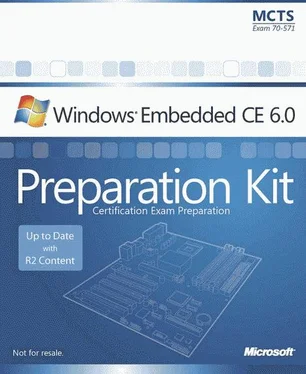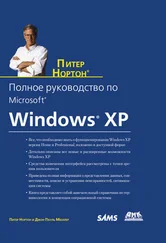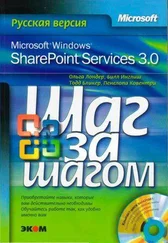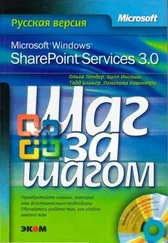Nicolas Besson - Microsoft Windows Embedded CE 6.0 Exam Preparation Kit
Здесь есть возможность читать онлайн «Nicolas Besson - Microsoft Windows Embedded CE 6.0 Exam Preparation Kit» весь текст электронной книги совершенно бесплатно (целиком полную версию без сокращений). В некоторых случаях можно слушать аудио, скачать через торрент в формате fb2 и присутствует краткое содержание. Город: Redmond, Год выпуска: 2008, Издательство: Microsoft, Жанр: Руководства, ОС и Сети, Программы, на английском языке. Описание произведения, (предисловие) а так же отзывы посетителей доступны на портале библиотеки ЛибКат.
- Название:Microsoft Windows Embedded CE 6.0 Exam Preparation Kit
- Автор:
- Издательство:Microsoft
- Жанр:
- Год:2008
- Город:Redmond
- ISBN:нет данных
- Рейтинг книги:5 / 5. Голосов: 1
-
Избранное:Добавить в избранное
- Отзывы:
-
Ваша оценка:
- 100
- 1
- 2
- 3
- 4
- 5
Microsoft Windows Embedded CE 6.0 Exam Preparation Kit: краткое содержание, описание и аннотация
Предлагаем к чтению аннотацию, описание, краткое содержание или предисловие (зависит от того, что написал сам автор книги «Microsoft Windows Embedded CE 6.0 Exam Preparation Kit»). Если вы не нашли необходимую информацию о книге — напишите в комментариях, мы постараемся отыскать её.
Microsoft Windows Embedded CE 6.0 Exam Preparation Kit — читать онлайн бесплатно полную книгу (весь текст) целиком
Ниже представлен текст книги, разбитый по страницам. Система сохранения места последней прочитанной страницы, позволяет с удобством читать онлайн бесплатно книгу «Microsoft Windows Embedded CE 6.0 Exam Preparation Kit», без необходимости каждый раз заново искать на чём Вы остановились. Поставьте закладку, и сможете в любой момент перейти на страницу, на которой закончили чтение.
Интервал:
Закладка:
Non-Real-Time APIs
When calling system APIs, or Graphical Windows Event System (GWES) APIs, be aware that some APIs rely on non-real-time features, such as for window drawing. Forwarding calls to non-real-time APIs may dramatically decrease system performance. Consequently, you should make sure that your APIs in real-time applications are real-time compliant. Other APIs, such as ones used for accessing a file system or hardware, can have an impact on performance because these APIs may use blocking mechanisms, such as mutexes or critical sections, to protect resources.
Non-real-time APIs can have a measurable impact on real-time performances and, unfortunately, the Win32® API documentation provides little detail on real-time issues. Practical experience and performance testing can help you choose the right functions.
Real-Time Performance Measurement Tools
Windows Embedded CE includes many performance monitoring and troubleshooting tools that can be used to measure the impact of Win32 APIs on system performance. These tools are helpful when identifying inefficient memory use, such as an application not releasing the system memory it allocates.
The following Windows Embedded CE tools are particularly useful to measure the real-time performance of your system components and applications:
■ ILTimingMeasures Interrupt Service Routine (ISR) and Interrupt Service Thread (IST) latencies.
■ OSBenchMeasures system performance by tracking the time the kernel spends managing kernel objects.
■ Remote Performance MonitorMeasures system performance, including memory usage, network throughput, and other aspects.
Interrupt Latency Timing (ILTiming)
The ILTiming tool is particularly useful for Original Equipment Manufacturers (OEMs) who want to measure ISR and IST latencies. Specifically, ILTiming enables you to measure the time it takes to invoke an ISR after an interrupt occurred (ISR latency) and the time between when the ISR exits and the IST actually starts (IST latency). This tool uses a system hardware tick timer by default, but it is also possible to use alternative timers (high-performance counters).
Not all hardware platforms provide the required timer support for the ILTiming tool.
The ILTiming tool relies on the OALTimerIntrHandler function in the OAL to implement the ISR for managing the system tick interrupt. The timer interrupt handler stores the current time and returns a SYSINTR_TIMING interrupt event, which an ILTiming application thread waits to receive. This thread is the IST. The time elapsed between the reception of the interrupt in the ISR and the reception of the SYSINTR_TIMING event in the IST is the IST latency that the ILTiming tool measures.
You can find the ILTiming tool's source code in the %_WINCEROOT%\Public\Common\Oak\Utils folder on your development computer if you have installed Microsoft Platform Builder for Windows Embedded CE 6.0 R2. The ILTiming tool supports several command-line parameters that you can use to set the IST priority and type according to the following syntax:
iltiming [-i0] [-i1] [-i2] [-i3] [-i4] [-p priority] [-ni] [-t interval] [-n interrupt] [-all] [-o file_name] [-h]
Table 3-1 describes the individual ILTiming command-line parameters in more detail.
Table 3-1 ILTiming parameters
| Command-Line Parameter | Description |
|---|---|
| -i0 | No idle thread. This is equivalent to using the -ni parameter. |
| -i1 | One thread spinning without performing any actual processing. |
| -i2 | One thread spinning, calling SetThreadPriority (THREAD_PRIORITY_IDLE). |
| -i3 | Two threads alternating SetEvent and WaitForSingleObject with a 10-second timeout. |
| -i4 | Two threads alternating SetEvent and WaitForSingleObject with an infinite timeout. |
| -i5 | One thread spinning, calling either VirtualAlloc (64 KB), VirtualFree, or both. Designed to flush the cache and the translation look-aside buffer (TLB). |
| -p priority | Specifies the IST priority (zero through 255). The default setting is zero for highest priority. |
| -ni | Specifies no idle priority thread. The default setting is equal to the number of idle priority thread spins. This is equivalent to using the -i0 parameter. |
| -t interval | Specifies the SYSINTR_TIMING timing interval, with clock ticks in milliseconds. The default setting is five. |
| -n interrupt | Specifies the number of interrupts. Using this parameter you can specify how long the test will run. The default setting is 10. |
| -all | Specifies to output all data. The default setting is to output the summary only. |
| -o file_name | Specifies to output to file. The default setting is to output to the debugger message window. |
ILTiming may create idle threads (command-line parameters: -i1, -i2, -i3, and -i4) to generate activity on the system. This enables the kernel to be in a non-preemptive kernel call that must be finished before handling the IST. It can be useful to enable idle threads in background tasks.
Operating System Benchmark (OSBench)
The OSBench tool can help you measure system performance by identifying the time that the kernel spends managing kernel objects. Based on the scheduler, OSBench collects timing measurements by means of scheduler performance-timing tests. A scheduler performance-timing test measures how much time basic kernel operations, such as thread synchronization, require.
OSBench enables you to track timing information for the following kernel operations:
■ Acquiring or releasing a critical section.
■ Waiting for or signaling an event.
■ Creating a semaphore or mutex.
■ Yielding a thread.
■ Calling system APIs.
To identify performance issues in different system configurations, use OSBench in conjunction with a stress test suite, such as the Microsoft Windows CE Test Kit (CETK).
The OSBench tool supports several command-line parameters that you can use according to the following syntax to collect timing samples for kernel operations:
osbench [-all] [-t test_case] [-list] [-v] [-n number] [-m address] [-o file_name] [-h]
Table 3-2 describes the individual OSBench command-line parameters in more detail.
Table 3-2 OSBench parameters
| Command-Line Parameter | Description |
|---|---|
| -all | Run all tests (default: run only those specified by -t option): |
| TestId 0: CriticalSections. | |
| TestId 1: Event set-wakeup. | |
| TestId 2: Semaphore release-acquire. | |
| TestId 3: Mutex. | |
| TestId 4: Voluntary yield. | |
| TestId 5: PSL API call overhead. | |
| TestId 6: Interlocked API's (decrement, increment, testexchange, exchange). | |
| -t test_case | ID of test to run (need separate -t for each test). |
| -list | List test ID's with descriptions. |
| -v | Verbose: show extra measurement details. |
| -n number | Number of samples per test (default=100). |
| -m address | Virtual address to write marker values to (default=). |
| -o file_name | Output to comma-separated values (CSV) file (default: output only to debug). |
Check out the OSBench source code to identify the test content. You can find the source code at the following locations:
Читать дальшеИнтервал:
Закладка:
Похожие книги на «Microsoft Windows Embedded CE 6.0 Exam Preparation Kit»
Представляем Вашему вниманию похожие книги на «Microsoft Windows Embedded CE 6.0 Exam Preparation Kit» списком для выбора. Мы отобрали схожую по названию и смыслу литературу в надежде предоставить читателям больше вариантов отыскать новые, интересные, ещё непрочитанные произведения.
Обсуждение, отзывы о книге «Microsoft Windows Embedded CE 6.0 Exam Preparation Kit» и просто собственные мнения читателей. Оставьте ваши комментарии, напишите, что Вы думаете о произведении, его смысле или главных героях. Укажите что конкретно понравилось, а что нет, и почему Вы так считаете.








